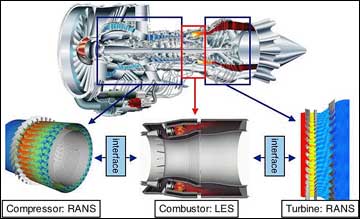|
|||
RANS
LES
Integration
Overview
Interface Dev.
Applications
Publications
People
Merrimac
Integration GroupOverview | Multi-code Interface Development | Applications | Publications | PeopleOverviewThe mission of the LES-RANS integration group is to develop the infrastructures to perform multi-code simulations and to demonstrate large-scale computations on the ASC computing systems. The two CITS flow solvers TFLO and CDP are combined for an aero-thermal flow simulation of an entire aero-engine gas turbine. TFLO is based on the Reynolds-Averaged Navier-Stokes equations and is used for the simulation of the flow through the combustor and the turbine. CDP is a Large Eddy Simulations tool and is employed for predicting the reacting multiphase flow in the combustor chamber. The following diagram illustrates the principle of integrated LES-RANS computations: 
One domain is computed with LES (here: the upstream domain), the other with RANS (here: the downstream domain). Both codes compute the unsteady evolution of the flow. The two domains overlap and both codes exchange flow data through the parallel network at each time step. The flow leaving the upstream domain enters the downstream domain. That means, the unsteady solution in the upstream domain delivers the inflow boundary conditions for the downstream domain. On the other hand, the downstream flow solution may have an influence on the upstream domain. Hence, the downstream domain provides flow data to the upstream domain in order to modify the outflow conditions. The major challenges are:
|


